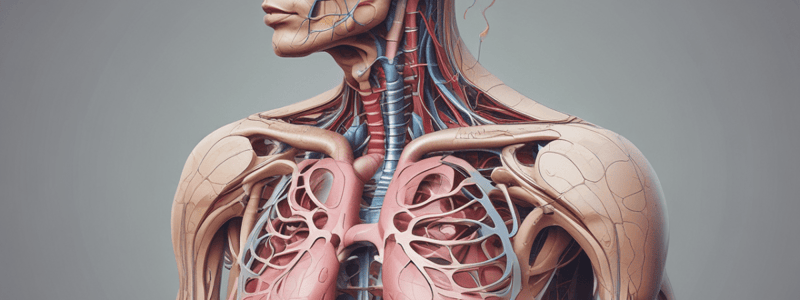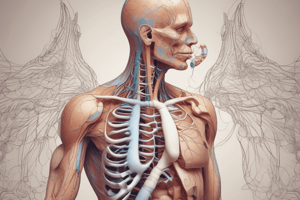Podcast
Questions and Answers
What is the primary function of the respiratory mucosa?
What is the primary function of the respiratory mucosa?
- To move air to and from exchange surfaces
- To produce sound
- To detect olfactory stimuli
- To secrete mucus and trap inhaled particles (correct)
What is the name of the voice box?
What is the name of the voice box?
- Larynx (correct)
- Trachea
- Epiglottis
- Glottis
What is the function of ciliated cells in the respiratory mucosa?
What is the function of ciliated cells in the respiratory mucosa?
- To secrete mucus
- To produce surfactant
- To sweep mucus out of the airways (correct)
- To engulf foreign particles
What maintains the shape of the trachea?
What maintains the shape of the trachea?
What is the term for the smallest airways that lead to the alveoli?
What is the term for the smallest airways that lead to the alveoli?
What is the function of surfactant in the alveoli?
What is the function of surfactant in the alveoli?
What determines the direction of air flow in the respiratory tract?
What determines the direction of air flow in the respiratory tract?
What is the term for the clusters of interconnected alveoli?
What is the term for the clusters of interconnected alveoli?
What is the function of alveolar macrophages?
What is the function of alveolar macrophages?
What is the term for the region of the respiratory tract where gas exchange occurs?
What is the term for the region of the respiratory tract where gas exchange occurs?
What is the function of goblet and gland cells in the respiratory mucosa?
What is the function of goblet and gland cells in the respiratory mucosa?
What percentage of CO2 is transported bound to hemoglobin?
What percentage of CO2 is transported bound to hemoglobin?
What is the name of the acid that 70% of CO2 is converted to in RBCs?
What is the name of the acid that 70% of CO2 is converted to in RBCs?
What part of the brain controls respiratory muscles?
What part of the brain controls respiratory muscles?
What is the effect of parasympathetic stimulation on bronchial smooth muscle?
What is the effect of parasympathetic stimulation on bronchial smooth muscle?
What is the term for the abnormal constriction of bronchial smooth muscle?
What is the term for the abnormal constriction of bronchial smooth muscle?
How many pairs of nuclei are found in the pons?
How many pairs of nuclei are found in the pons?
Which muscles are responsible for elevating the ribs and sternum during inspiration?
Which muscles are responsible for elevating the ribs and sternum during inspiration?
What is the term for the volume of air remaining in the lung after a forced expiration?
What is the term for the volume of air remaining in the lung after a forced expiration?
What happens to hemoglobin's oxygen-binding ability if the pH falls or the temperature rises?
What happens to hemoglobin's oxygen-binding ability if the pH falls or the temperature rises?
What is the process of diffusion of gases between alveolar air and pulmonary capillary blood?
What is the process of diffusion of gases between alveolar air and pulmonary capillary blood?
What is the direction of oxygen binding to hemoglobin in response to an increase in PO2 in plasma?
What is the direction of oxygen binding to hemoglobin in response to an increase in PO2 in plasma?
Flashcards are hidden until you start studying
Study Notes
Functions of Respiratory System
- The respiratory system facilitates gas exchange between blood and air
- It moves air to and from exchange surfaces
- Protects exchange surfaces from environmental variations and pathogens
- Produces sound
- Detects olfactory stimuli
The Respiratory Tract
- Conducting portion: conducts air movement from nares to small bronchioles
- Respiratory portion: gas exchange region, comprising respiratory bronchioles and alveoli
Respiratory Mucosa
- Comprises respiratory epithelium, supporting connective tissue, and mucous glands
- Lines nasal cavity and most airways
- Goblet and gland cells secrete mucus
- Mucus traps inhaled dirt, pathogens, etc.
- Ciliated cells sweep the mucus out of the airways into pharynx
- Irritants stimulate secretion, causing “runny nose”
The Larynx
- Also known as the “voice box”
- Made of nine cartilages
- Air passes through glottis
- Covered by epiglottis during swallowing
- Keeps solids, liquids out of airways
- Made of elastic cartilage
- Supports true vocal cords
- Exhaled air vibrates true vocal cords to make sound
The Trachea
- Also called “windpipe”
- Stiffened by C-shaped cartilage rings
- Esophagus stuck to posterior surface
- Cartilage missing there
- Trachea distorted by balls of food as they pass down esophagus to stomach
The Bronchi
- Trachea forms two branches: right and left primary bronchi
- Primary bronchi branch to form secondary bronchi
- Each secondary bronchi ventilates a lobe
- Secondary bronchi branch to form tertiary bronchi
- Tertiary bronchi branch repeatedly
- Cartilage decreases, smooth muscle increases
The Alveolar Ducts and Alveoli
- Gas exchange regions of the lung
- Respiratory bronchioles lead into alveolar ducts
- Ducts lead into alveolar sacs
- Sacs are clusters of interconnected alveoli
- Gives the lung an open, spongy look
- Approximately 150 million alveoli per lung
Anatomy of the Alveolus
- Respiratory membrane: simple squamous epithelium, capillary endothelium, and shared basement membrane
- Septal cells produce surfactant to reduce collapse
- Alveolar macrophages engulf foreign particles
Air Flow
- Determined by the relationship of atmospheric pressure and pressure inside the respiratory tract
- Flow is always from higher to lower pressure
Muscles of Respiration
- Primary inspiratory muscles: diaphragm and external intercostals
- Relaxed normal expiration is a passive process
- Muscles of inspiration elevate the ribs and sternum
- Muscles of expiration depress the ribs and sternum
- Forceful expiration involves internal intercostals and abdominal muscles
Gas Exchange
- External respiration: diffusion of gases between alveolar air and pulmonary capillary blood across the respiratory membrane
- Internal respiration: diffusion of gases between blood and interstitial fluids across the capillary endothelium
- Hemoglobin binds most oxygen in the bloodstream, releasing more oxygen as PO2 decreases, pH falls, or temperature rises
Carbon Dioxide Transport
- Aerobic metabolism produces CO2
- 7% of CO2 travels dissolved in plasma
- 23% of CO2 travels bound to hemoglobin as carbaminohemoglobin
- 70% of CO2 is converted to H2CO3 (carbonic acid) in RBCs
Respiratory Control
- Respiratory centers in brainstem: three pairs of nuclei (two in pons, one in medulla oblongata)
- Control respiratory muscles and set rate and depth of ventilation
- Respiratory rhythmicity center in medulla sets the basic rhythm of breathing
Respiratory Mucosa
- Respiratory epithelium plus supporting connective tissue with mucous glands
- Lines nasal cavity and most airways
- Goblet and gland cells secrete mucus, which traps inhaled dirt, pathogens, etc.
- Ciliated cells sweep mucus out of airways into pharynx
- Irritants stimulate mucus secretion, causing a "runny nose"
- Smooth muscle in wall controlled by ANS (Sympathetic: bronchodilation, Parasympathetic: bronchoconstriction)
- Excess bronchoconstriction is asthma
Studying That Suits You
Use AI to generate personalized quizzes and flashcards to suit your learning preferences.




